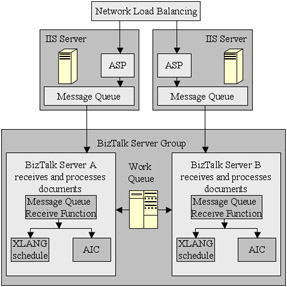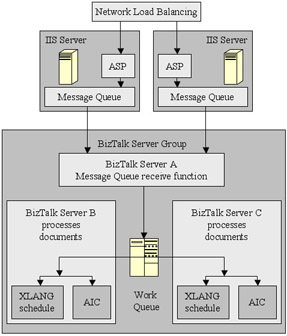4.3 Designing BizTalk Server Groups
|
| < Day Day Up > |
|
A BizTalk Server group is a collection of centrally managed individual Biz- Talk Servers that need to be monitored and configured together. BizTalk uses a number of queues to process incoming and outgoing documents, and a BizTalk Server group can contain servers doing all of these tasks or allocate a specific role to individual servers within the group to achieve better performance and fault tolerance.
The redundant server group configuration has all of the group BizTalk Servers configured to share the same queue, tracking, and messaging database. In this case an ASP page is created to receive incoming documents and place them into the appropriate message queue, which is then placed into the work queue. Whichever server is available will then pick up the document from the queue and process it, allowing any server in the group to process incoming documents (see Figure 4.18).

Figure 4.18: BizTalk redundant server group.
In the partitioned or specialized server group, the BizTalk Servers are configured to share the same queue, tracking, and messaging management database, but at least one server is configured to receive documents from the HTTP transport service. When a document arrives in the message queue, it is picked up and submitted to another BizTalk Server. The end result is faster processing of documents since they are prevented from building up in the message queue (see Figure 4.19).

Figure 4.19: BizTalk partitioned or specialized server group.
4.3.1 BizTalk 2002 Developments
BizTalk 2002 introduced a number of new features to the product:
-
Deployment of BizTalk solutions has been difficult, because there were limited tools to assist in the development/staging/deployment cycle. BizTalk 2002 introduced a set of drivers that allows it to work with Application Center Server (see Chapter 8), improving the deployment across multiple servers.
-
Super Effective and Efficient Delivery, or SEED was developed by the internal IT group at Microsoft. The idea was to reduce the amount of time and effort it took to connect a BizTalk Server to multiple trading partners. SEED gives trading partners a user interface to configure and test their BizTalk connections.
-
A set of new monitoring tools designed for use with Microsoft Operations Manager, or MOM contains 900 preset alerts and rules for use in customizing a BizTalk installation.
-
The BizTalk Server Toolkit for Microsoft .NET, which now comes with BizTalk Server, allows business process orchestration with XML Web services. In addition, orchestration has been improved, allowing separate transaction and exception handling, XLANG schedule pooling, and XLANG correlation, which allows multiple schedule instances to use a single message queue.
-
A new HTTP Receive function is now included, configured from within BizTalk Server and designed to give fast performance.
-
Database management and utilities have been improved, allowing the SQL Server database used by BizTalk Server to be managed directly. This provides useful features, such as manual restore of databases, deletion of records from the persistence database, and automatic expiration of timed-out items in the tracking database.
-
The BizTalk Server administration console can now be installed on a remote computer and allowed to manage any BizTalk Server in that environment.
-
SQL Server integrated security, which now allows BizTalk Server to use Windows 2000 credentials to determine privileges rather than SQL Server credentials.
|
| < Day Day Up > |
|
EAN: 2147483647
Pages: 136